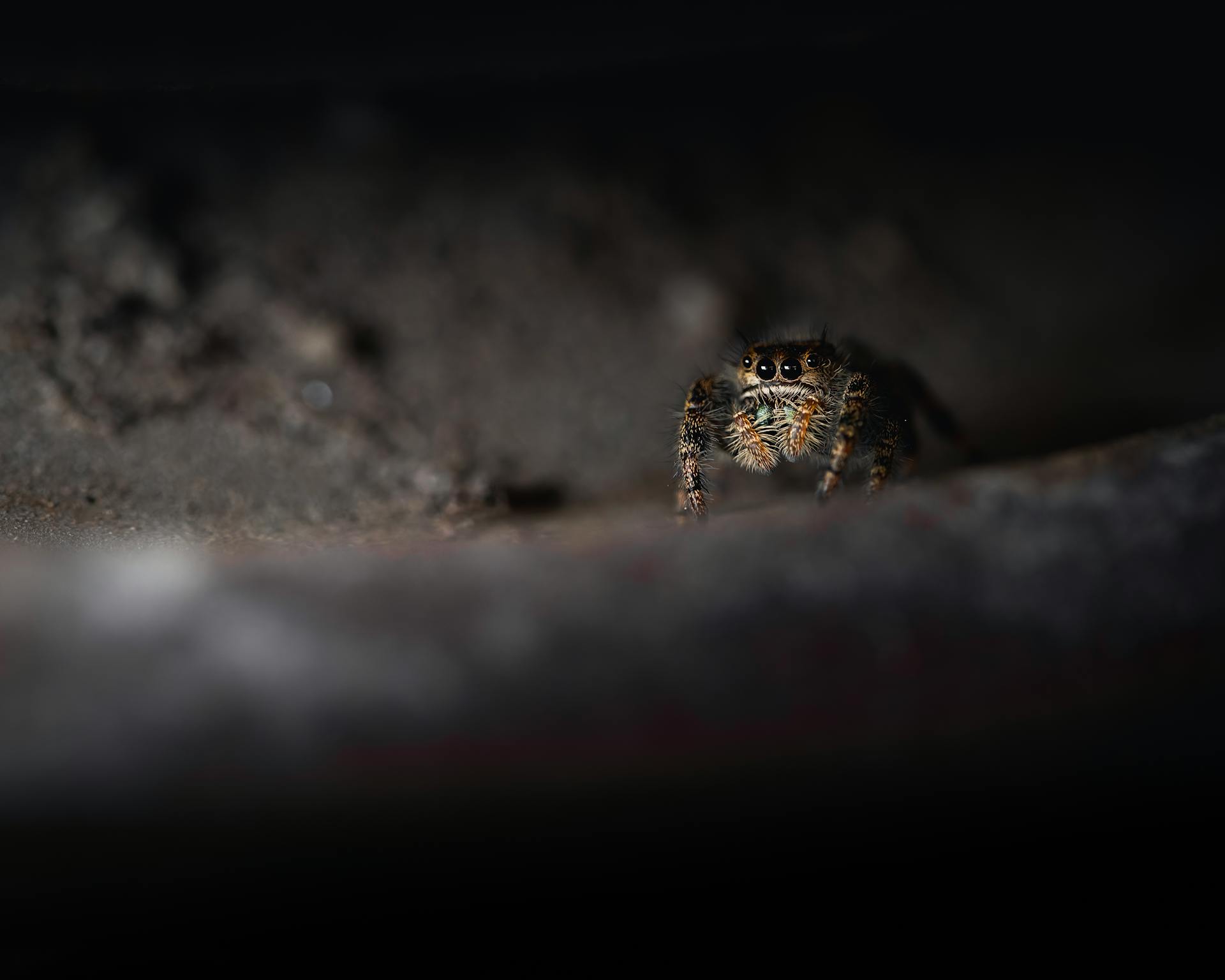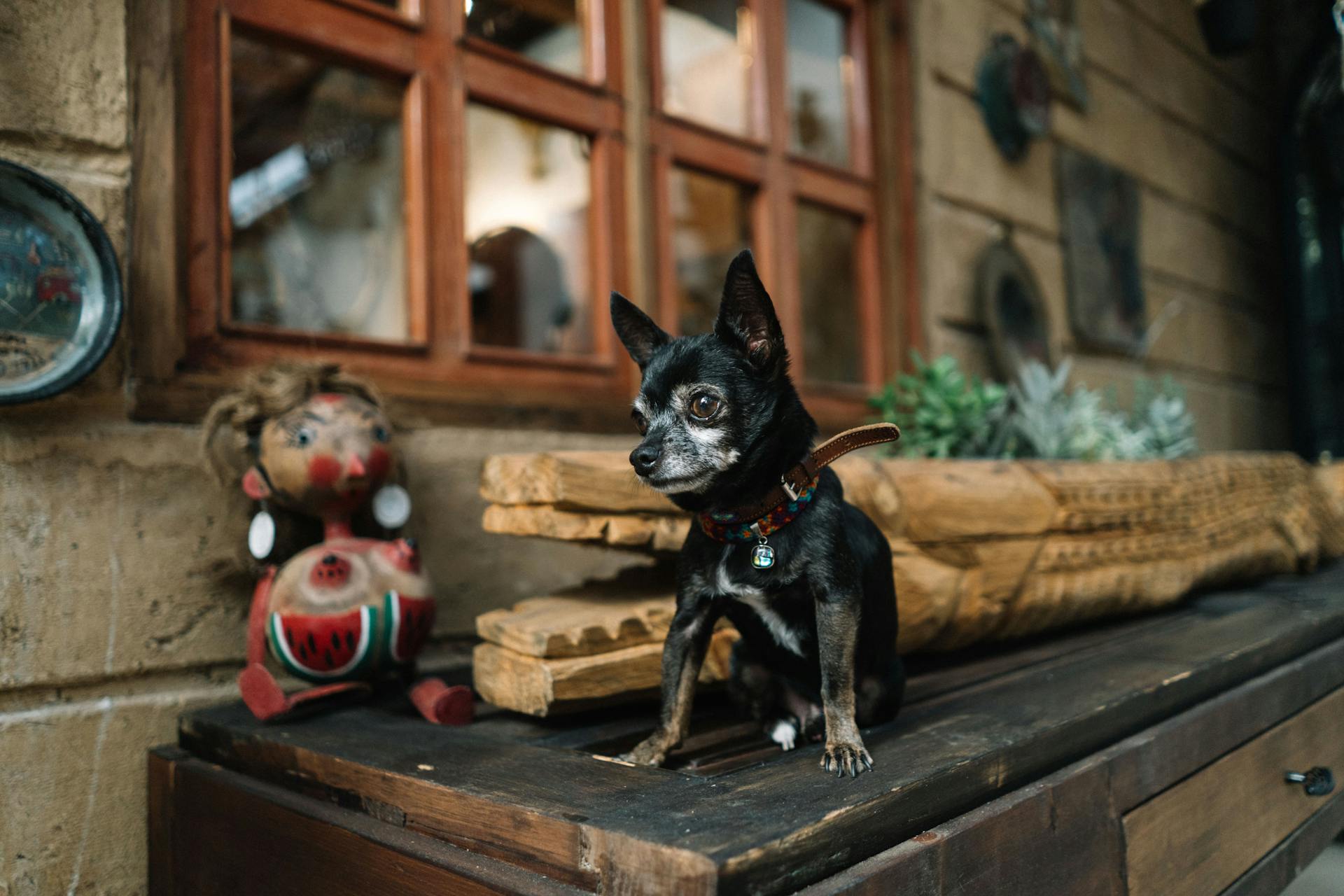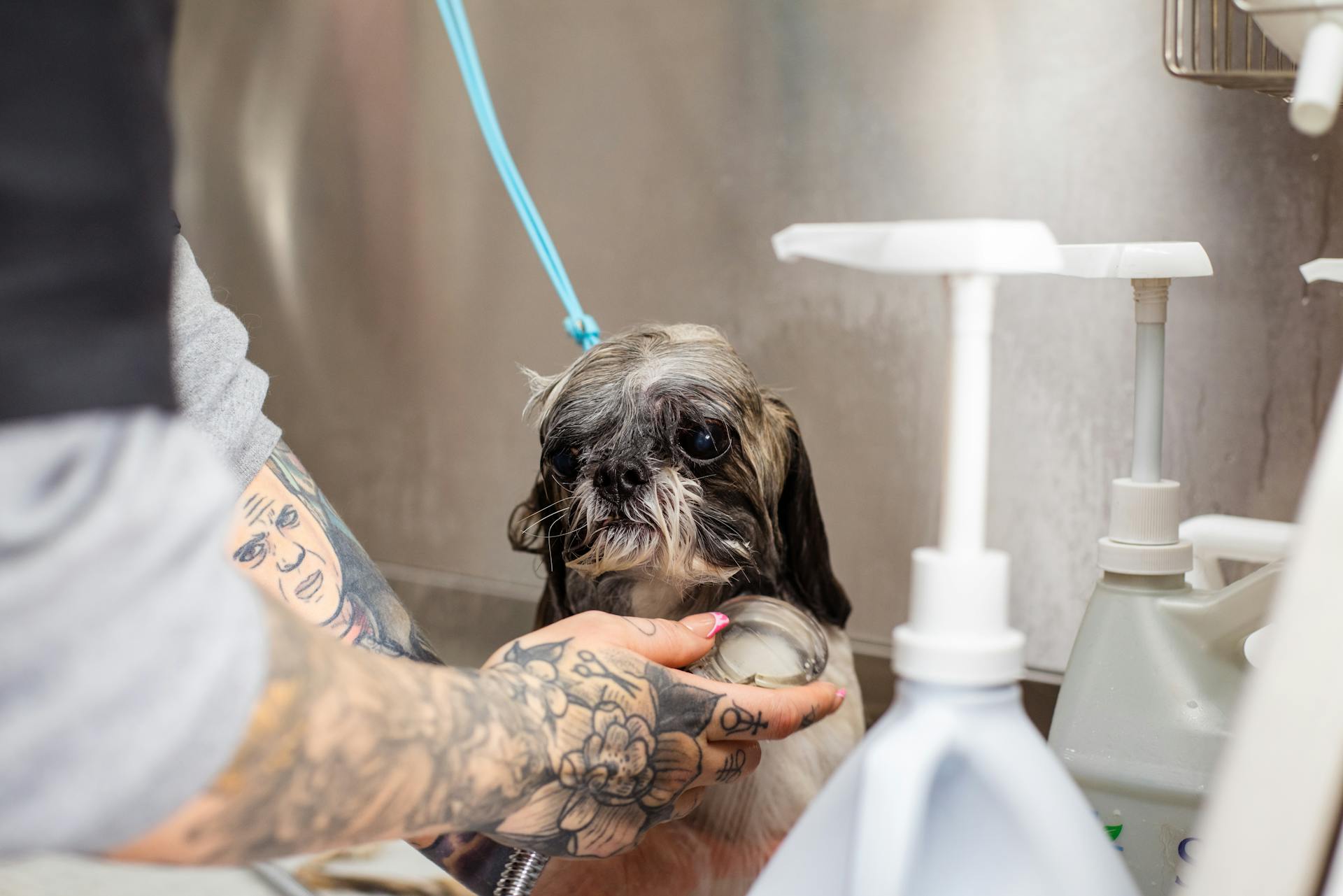
Training a skittish dog requires patience and understanding of their unique needs. Skittish dogs are naturally wary of new people, places, and things, making them more prone to fear-based behaviors.
One key aspect of skittish dog training is recognizing and addressing the underlying causes of their fear. This often involves identifying triggers such as loud noises or strangers, and developing strategies to desensitize them to these stimuli.
Building trust with your skittish dog is essential for successful training. This can be achieved by establishing a consistent routine, using positive reinforcement techniques, and providing a safe and comfortable environment.
A well-structured training plan can help you make progress with your skittish dog, even if they're initially resistant to new experiences.
Check this out: Fear Aggression Dog Training
Choosing the Right Approach
You'll need to consider the level of your dog's anxiety before deciding on a training approach. Talk to your vet for advice on how to help your dog become more confident.
Some dogs may require professional help, such as a behaviorist or trainer, to overcome their skittish behavior. Enlist the services of one with experience dealing with skittish dogs and be prepared to work with them regularly.
Building trust and confidence in your dog is key to successful training. Be patient and give your dog plenty of time and space to get used to you.
Choose a Leash
Choosing a leash can make a big difference in your dog's training experience. A small, light clip can reduce distress for a dog who's never been on a leash before.
For a new leash, look for one with a clip that's easy to manipulate – you don't want to spend time fumbling with it while you're trying to train. This can be especially helpful if you're working with a nervous or anxious dog.
A lightweight leash made from light material and a thin design can also make a big difference. This can help reduce the weight and pressure on your dog's collar or harness, making them more comfortable.
A short leash can be especially helpful in the early stages of training. This can help you maintain control and focus your dog's attention on you.
For another approach, see: Do Dog Diapers Help with Potty Training
Get Professional Help

You don't have to tackle fearful dog training alone. Decide how slowly you need to progress through the training plan, and then move twice as slowly as that. This will help you make faster progress and feel less stressed.
It's worth considering reaching out to your vet for advice on how to help your dog become more confident. In some situations, medications can really help dogs overcome their initial anxiety.
Having a professional behaviorist or trainer with experience dealing with skittish dogs can make a huge difference. Explain the problems you're having and be prepared to work with them regularly until your dog is behaving the way you want them to.
Some trainers will work with you and your dog in your home, while others will have you take your dog to them.
Broaden your view: Does Spaying a Dog Help with Aggression
About This Article
Before choosing the right approach, it's essential to understand that every dog is unique and requires a tailored strategy. Building trust and confidence in your dog is key to a successful training process.

Patience is crucial when working with a timid dog, as they need time and space to get used to you. Establishing authority through calm and assertive behavior is also vital.
Avoid rewarding timid behaviors by making a fuss whenever your dog gets scared, as this can reinforce fearfulness. Give your dog plenty of time to warm up to new experiences and reward them for successfully dealing with new situations.
Introducing new experiences slowly and rewarding your dog for bravery can help build their confidence. For example, giving your dog a treat and praise when they approach you on their own can be a great motivator.
Get to Know
Getting to know your dog at their own pace is crucial, as it allows you to learn about their wants and needs without forcing them into anything.
Pay attention to signs that your pup needs space, such as licking their lips, yawning, panting, tucking their tail between their legs, and averting their gaze. If you notice these behaviors, respect their space and try again a little later.

Avoid big gestures and keep your tone of voice low and calm as your dog gets used to their new home. This will help them feel more at ease.
If you're taller than average, try sitting on the ground and letting your dog come to you. This will help them feel less intimidated and more comfortable.
Pet your dog on areas like their back, avoiding sensitive areas like their head, ears, tail, and paws. This will help them feel more relaxed and build trust with you.
Building Trust and Confidence
Building trust and confidence with your skittish dog is key to overcoming their anxiety. To instill trust, you must show your dog that when something scary happens, it's going to be okay. Be patient and give your dog space, and they will come on their own.
Establishing yourself as the alpha is crucial. You must project a calm and assertive energy when something scary happens, and never confuse empathy with allowing your dog to be dominant. Your dog needs to know that you're in control.
To build confidence, introduce your dog to new situations where they can observe and learn from other confident dogs and people without feeling threatened. This can take the form of obedience training, obstacle courses, or breed-specific skills training.
Rewarding your dog with treats and praise is essential. Hold a few dog treats in your hand and give them a few treats when they come near you. This will teach them that being with you is rewarding.
Gradually introducing your dog to more and more experiences is vital. Once they've started building confidence, don't let them plateau or grow bored. New experiences are key to their progress.
Here are the 6 steps to building trust and confidence with your skittish dog:
- Earn your dog's trust by being patient and showing them that you're in control.
- Establish yourself as the alpha by projecting a calm and assertive energy.
- Build confidence by introducing your dog to new situations and rewarding them with treats and praise.
- Give your dog space and let them come to you.
- Gradually introduce your dog to more and more experiences.
- Devote yourself to helping your dog overcome their anxiety.
Remember, building trust and confidence with your skittish dog takes time and patience. Don't give up on them, and always focus on rewarding positive behavior.
Understanding and Managing Fear
It's essential to understand that skittish behavior in dogs is often driven by anxiety, so it's crucial to approach the situation with a calm and neutral demeanor.
Curious to learn more? Check out: It's Your Choice Dog Training
Rewarding confidence, not anxiety, is a key principle in managing fear. This means giving neutral reactions to anxious behavior and lots of praise and rewards to more confident strides.
Identifying the triggers of your dog's anxiety is vital to effective training. Find out what specifically sets them off, whether it's people ringing the doorbell or seeing strangers approach while on a walk.
Your reaction to your dog's anxiety can actually contribute to the problem. If you get nervous and skittish when people visit, your pup will likely respond similarly.
Socialization is a powerful tool in helping your dog overcome fear and build confidence. Give your dog the opportunity to interact with other dogs, preferably one that is very comfortable and trusting with humans.
It's essential to avoid overwhelming your dog with too many new experiences at once. Start with small, controlled interactions and gradually increase the exposure to new situations.
Recommended read: Dog Fear Aggression
Creating a Comfortable Environment
Your home is your sanctuary, and it should be the same for your new pup. Place your pup in a room that isn’t too big or small where they can feel safe.
Giving your dog their own space and time to get comfortable will allow them to gradually open up in their own way. This is especially important for skittish dogs who need time to adjust to new surroundings.
Developing a routine will also help your dog feel more secure, as dogs love routines and they learn them quickly.
If this caught your attention, see: Will Neutering a Dog Stop Aggression
Create a Comfortable Space
Creating a comfortable space is crucial for your rescue dog's adjustment to their new home. Your home is your sanctuary, and it's going to be the same for your new pup.
A room that's not too big or small is ideal for your dog to feel safe. Place your pup in a room with a nice dog bed or a place to hide if they need it.
Giving your dog their own space and time to get comfortable will allow them to gradually open up in their own way. This will help them feel more at ease in their new environment.
Additional reading: Dog Mat Training
Develop Routines

Developing routines is crucial for creating a comfortable environment for your dog. Dogs love routines and they learn them quickly.
Sticking to a routine will make both your lives easier, and you may find that it helps eliminate anxiety and skittish behavior. This is because dogs thrive on predictability and knowing what to expect.
Try to establish a daily schedule that includes regular feeding times, exercise, and playtime. This will help your dog feel more secure and in control.
By sticking to a routine, you can also help your dog learn new behaviors and build trust with you. Don't be too hard on yourself if you can't stick to the routine perfectly - some flexibility is okay.
Supplements and Calming Aids
Supplements and Calming Aids can be a great way to create a sense of calm for your nervous dog. There are pheromone or essential oil based products available as diffusers, sprays, and wipes that can help.
Some products contain ingredients like L-Tryptophan, GABA, or alpha-casozepine, which help promote and sustain natural calming pathways. If you're not sure, talk to your vet.
You can use these products to create a calm environment for your dog, and it's a good idea to experiment with different types to see what works best for your pet.
Training Techniques and Methods
Desensitizing your dog to your movement is key in skittish dog training. This can be achieved by having a high-value food in your hand and walking towards your dog while speaking in soothing tones.
Drop the object near your dog and keep walking, repeating this process daily or multiple times a day until your pup starts to perk up when they see you approaching. This will help them feel more comfortable and secure about your movement.
Continue talking to your dog in soothing tones even after you've dropped the treat, and avoid interfering with the food they're eating. This is crucial, as taking food away can reinforce their fear and make it harder to connect with your pup.
Suggestion: Dogs Walking Backwards
Featured Images: pexels.com


